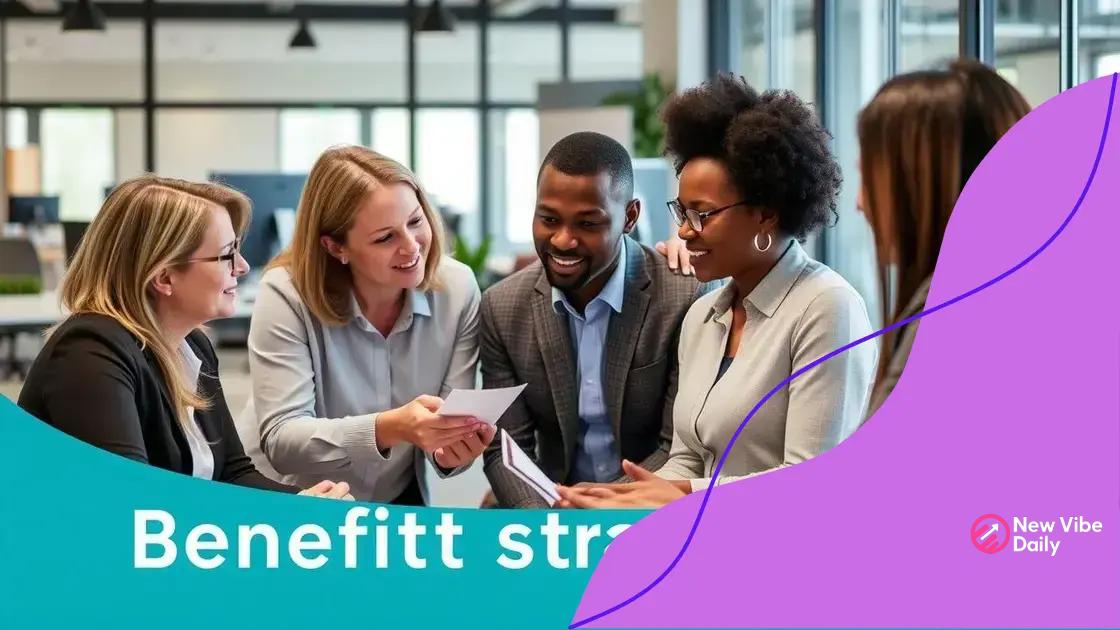Aging workforce impact on benefits

The aging workforce impacts benefits significantly, requiring companies to adapt retirement plans, healthcare options, and flexible work arrangements to meet the unique needs of older employees for improved retention and satisfaction.
Aging workforce impact on benefits is a pressing issue in today’s economy. As employees grow older, how companies respond can significantly affect morale and retention. What changes are we witnessing in workplace perks?
Understanding the aging workforce
Understanding the aging workforce is crucial for today’s businesses. As individuals grow older within the workplace, their experiences and needs evolve. Companies must adapt to keep these valuable employees engaged and productive.
Demographics of the Aging Workforce
Recent studies show that a significant portion of the workforce is over the age of 50. This shift impacts everything from benefits to job roles. Employers need to recognize the importance of this demographic.
Why It Matters
It’s essential to understand the impact of an aging workforce. Employee retention, knowledge transfer, and mentoring are all areas affected. Adapting to this change can lead to better productivity and morale.
- Retention of experienced workers boosts team morale.
- Knowledge transfer prevents loss of essential skills.
- Flexible work arrangements can enhance productivity.
As roles change, businesses must think about how they can help older employees stay engaged. Providing opportunities for training and growth can create a more inclusive environment.
Consider implementing a staggered retirement program. This allows workers to transition gradually, sharing their expertise while showing the next generation how to take over. The benefits extend beyond the individual employee; they resonate throughout the entire organization, fostering a culture of learning and adaptation.
Identifying Challenges
Challenges such as health-related issues or skills gaps can arise with an aging workforce. Companies need to address these proactively. For example, additional health benefits or flexible working hours may be necessary to accommodate older workers.
- Health programs specific to older employees can enhance well-being.
- Training programs tailored for older workers can bridge skills gaps.
- Flexible hours may help balance personal needs with work responsibilities.
As we look at the future, the need to understand the aging workforce will only grow. Taking proactive steps now will prepare businesses for the changes ahead and ensure they remain competitive in the market.
Key benefits affected by aging employees
Key benefits affected by aging employees play a vital role in shaping workplace dynamics today. As the workforce ages, organizations must reconsider how they design and implement benefits packages to meet the diverse needs of their older employees.
Retirement Plans
One significant area impacted by an aging workforce is retirement plans. Older employees often look for plans that provide financial security. Companies should offer diverse retirement options to meet these needs.
- Flexible contribution plans allow for tailored personal investments.
- Pension plans can provide a steady income stream in retirement.
- Financial planning services help employees prepare effectively.
Beyond retirement, healthcare benefits also require attention. As employees age, their healthcare needs tend to increase, making comprehensive coverage essential. Employers can enhance their offerings by considering wellness programs.
Healthcare Benefits
Providing robust healthcare benefits is crucial for retaining aging employees. Comprehensive medical coverage can reduce stress about healthcare costs and promote a healthier workforce.
- Offering preventative care options can help catch potential issues early.
- Flexible spending accounts can assist with coverage for out-of-pocket expenses.
- Partnerships with local health providers can offer discounts or special services.
Another benefit that resonates with aging employees is flexible work arrangements. Many older workers appreciate the ability to balance their professional and personal lives.
Flexible Work Arrangements
Flexible schedules and remote work options can significantly impact employee satisfaction among aging workers. Allowing employees to structure their days can lead to improved productivity and morale.
- Remote work can reduce commuting stress and time.
- Flexibility can support caregiving responsibilities for family members.
- Part-time options can ease the transition to retirement.
By understanding the key benefits affected by aging employees, organizations can create a supportive environment that recognizes and meets the needs of a diverse workforce. This approach not only aids in retaining skilled employees but also fosters a culture of inclusivity and understanding.
Strategies to adapt workplace benefits

Strategies to adapt workplace benefits are essential for businesses aiming to support an aging workforce. As employees grow older, companies must reevaluate their benefits to fit new needs and preferences.
Assess Current Benefits
The first step in adapting workplace benefits is to assess what is currently offered. Understanding the gaps in your existing benefits can help determine what needs to change.
- Conduct employee surveys to gather feedback.
- Analyze utilization rates of current benefits.
- Identify trends in benefits usage among older workers.
By knowing what employees value, businesses can tailor their approach. Adaptations should focus on enhancing the benefits that matter most. This makes sure older employees feel supported.
Implement Flexible Work Options
Flexible work options are crucial for meeting the needs of an aging workforce. Allowing employees to choose their hours or work remotely can lead to higher satisfaction.
- Hybrid work models can attract and retain older talent.
- Job sharing can help ease employees into retirement.
- Adjusting schedules for easier commute can promote well-being.
Creating a culture of flexibility also promotes a positive work-life balance. An aging workforce often balances personal responsibilities, making these options critical.
Enhance Health and Wellness Programs
Another important strategy is to enhance health and wellness programs. Providing benefits that focus on preventative care helps older employees maintain their health.
- Offer exercise classes tailored for older employees.
- Include mental health resources to support well-being.
- Encourage regular health screenings and check-ups.
These programs not only improve overall employee health but also reduce absenteeism and healthcare costs for the organization. Engaging older workers in wellness initiatives can be particularly effective.
By adopting these strategies, companies can better adapt their workplace benefits. This creates an inclusive work environment where aging employees feel valued and supported while still contributing effectively.
The role of technology in support
The role of technology in support of an aging workforce is increasingly important. As employees age, technology can help enhance their experience and efficiency at work.
Improving Accessibility
Technology can make workplaces more accessible for older employees. Tools like screen readers and voice recognition software help those with visual or mobility challenges.
- Adaptive devices can assist with physical tasks.
- Robust training modules can help older staff learn new technology.
- Online resources provide ongoing support outside of traditional settings.
By leveraging these advancements, companies can ensure all employees can perform their duties effectively.
Streamlining Communication
Technology also plays a vital role in communication. Older employees may find new platforms intimidating, but with the right support, they can thrive.
- Video conferencing can facilitate remote work and collaboration.
- Instant messaging tools can improve team interactions.
- Social media platforms help foster community among employees.
These tools help break down barriers, enabling collaboration and feeling included in teams. When communication is open, it allows for sharing ideas and feedback across all age groups.
Another significant technological aspect is data management. Modern systems can streamline routine tasks, saving time and reducing stress for aging employees.
Data Management Solutions
Implementing user-friendly software can greatly ease the workload. Intuitive interfaces allow older employees to complete tasks without a steep learning curve.
- Cloud-based systems facilitate easy access to necessary files.
- Automated reminders can help manage deadlines.
- Analytics tools enable better decision-making with less manual effort.
By embracing these technology solutions, companies can support their aging workforce effectively. The integration of technology not only enhances productivity but also creates an inclusive environment where all employees can succeed.
Case studies of successful adaptations
Case studies of successful adaptations demonstrate how organizations can effectively support their aging workforce. These examples reveal the positive impact of thoughtful changes in workplace practices and benefits.
Example 1: Tech Company
A leading tech company implemented flexible work hours for their older employees. This change allowed them to work when they felt most productive. As a result, employee satisfaction increased, leading to higher retention rates.
- Older employees reported feeling less stressed with flexible hours.
- Productivity improved as they could choose their peak working times.
- The company saw a 20% increase in employee engagement scores.
This approach not only helped individual employees but also created a more dynamic team culture.
Example 2: Healthcare Provider
A local healthcare provider introduced mentorship programs where older employees coached younger staff. This strategy fostered knowledge transfer and enhanced teamwork.
- Older staff felt valued for their expertise.
- Younger employees gained practical knowledge quickly.
- Team performance metrics improved significantly.
This case shows how integrating the experience of older workers can benefit the entire organization.
Example 3: Retail Giant
A major retail chain redesigned their training programs to be more engaging and accessible for older employees. They incorporated technology and hands-on learning methods tailored to varied learning styles.
- Workers found the new training more effective.
- Employee retention improved by 15% as staff felt more competent and confident.
- Sales increased due to better-trained employees serving customers.
These successful adaptations highlight the significance of understanding the aging workforce’s needs. When organizations invest in tailored strategies, they reap the benefits of loyalty, knowledge, and increased productivity.
FAQ – Key Questions about the Aging Workforce and Benefits
How can adapting benefits improve employee retention?
Adapting benefits to meet the needs of an aging workforce creates a supportive environment, which increases job satisfaction and reduces turnover.
What technologies can help support older employees?
Technologies like adaptive devices, communication tools, and user-friendly software can enhance accessibility and improve productivity for older employees.
Why is mentorship important in a diverse workforce?
Mentorship programs encourage knowledge sharing between generations, fostering collaboration and increasing overall team effectiveness.
What are some successful strategies for supporting aging employees?
Flexible work options, comprehensive health benefits, and enhanced training programs are effective strategies for supporting aging employees in the workplace.






